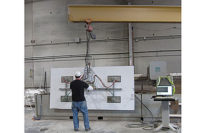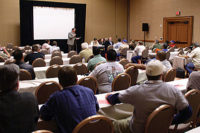For those not very into digital technology, it would be great to hear your thoughts as well. Is it cost? Learning curve? Efficiency?
Dan Riccolo, Morris Granite, Morris IL: We use digital scheduling (Moraware), and it has helped us to streamline communications involved with scheduling. It also helps the invoicing, quoting and sales process in general. It allows us to store and retrieve information much faster and more efficient than with paper files. The information is accessible from anywhere with internet service, which is very convenient.
As far as digital templating and production goes, we have been unable to integrate it fully into our processes. We have made some efforts, but for us, it seemed too dependent on any one section of the information chain. Plus the small size of our production makes the financial burden unrealistic and an unwise business decision, at least for the moment. I do understand the benefit and wish we could further leverage digital technology to our advantage. Some day, hopefully sooner than later. Better late than never.
Rick George, Lonnie’s Stone-Crafters, Rockford, IL: For scheduling, we also use Moraware software. Years ago when we bought it, I couldn’t get myself away from still using the erasable white board, as it was “familiar.” After finally switching over exclusively to Moraware, I don’t know how I’d run my business without it.
For templating, we have been using the LT-55 from Laser Products for the last five-plus years and will not ever go back to “stick” templates.
For slab layouts, we use SlabSmith software, and now we can create perfect color/direction flow through our seams and the entire kitchen, and we can share this with the homeowners so that they can see what their kitchen will look like before we ever make a cut. Our customers love this. It helps us give our customers a better looking kitchen with the peace of mind knowing what it will look like ahead of time.
For cutting/routing, we run a Northwood FabCenter. The CNC cutting works precisely with the SlabSmith to cut the parts exactly to where they were laid out and much faster than manual.
Before this, we still did very tight nesting, and on our Park Yukon manual saw, it would take us about 1 ½ to 2 hours to accurately cut a slab. Now with the CNC saw, that time has gone to about 15 minutes per slab. The CNC router will accurately finish off all the edge work, sink cutouts, etc. so that there is minimal hand work to finish off the parts.
The entire process has helped us create a more accurate, better quality countertop in less time, which means less cost to the consumer.
As far as the learning curve goes, it definitely takes time to learn all the new technologies, but by buying from quality companies, we have always received excellent help in learning how to use it all. For some of these products, there may be less costly stuff out there, but how much does down time cost you if you can’t get help? I think the main key is to buy from quality companies that will help you after the sale.
Miles Crowe, Crowe Custom Countertops, Inc., Atlanta, GA: We believe in digital. We are digital from sales all the way through production. We advertise and market digitally (Internet). We schedule and manage digitally (Moraware JobTracker). We template digitally (Prodim Proliner and Laser Products LT-55). We handle sales and layout with the help of SlabSmith. We cut with a Northwood SawJet and machine with a Northwood 138 CNC.
Our latest venture has been the implementation of a barcode inventory and job tracking system. We now manage our inventory digitally. Each piece is tracked via barcode until it is cut. Then the pieces are barcoded and tracked through the shop. Then we verify that each piece has gone through Quality Control and is ready to ship.
Becoming digital has increased our production capacity without having to add people. We took our first step into digital in 2005 with a CNC. At that point, we were doing about 10 to 12 kitchens a week with seven people in the shop. Now we are doing 40 to 50 kitchens a week with 10 people in the shop. We’ve had to add people in other areas — sales, installs, administration — but our production has become more efficient and less expensive.
The learning curve has not been bad. When we purchased the first CNC, I had no experience with anything digital. But I personally went for training. We were producing on the machine effectively within a month. Now almost everyone in the shop is digitally capable. My sawman became the SawJet operator and now programs. One of the fabricators became the CNC operator and can program and set-up tooling. My shop forman (who had zero computer experience) can program everything in the shop.
The number one most important thing is committing to the process. It took our guys a while to believe in the CNC at first. The same was true with the SawJet. But once they saw that it made the process smoother and their lives a little easier, they have been quick to accept more recent changes.
The hardest thing about the switch to digital is that we have become reliant on the technology. We crashed the hard drive on our programming computer about two months ago and had no backup. We were down for two and a half days. Luckily, we remembered enough about hand fabrication to get by (barely). But it did make us realize how dependent we had become on the machines.
Ken Lago, Granite Countertop Experts llc, Hampton, VA: The future is digital and automated for sure, but one cannot forget hand skills and to keep on learning from the older generation of stonemasons. Not knowing those skills — and using them — you cannot expect anyone to view you as knowledgeble about the product you are selling. Learning is power, sharing is power and prosperity is the result.
In production and templating, I went 100% digital awhile ago to keep up with the time we live in, but our scheduling and bidding is still done the old way.
Joey Marcella, Mario & Son, Inc., Liberty Lake, WA: Our experience with digital technology is similar to Miles’ shop — completely digital from marketing to installation. Breton barcode technology was introduced to our production when we built our new facility in 2007, networked through our CAD department to our waterjet, CNC saw, automated warehouse and CNCs.
We have recently introduced barcoding as well — through Moraware — for slab, sink and consumables inventory. We stopped using the traditional dry-erase boards, and have replaced them with flat-screen monitors in the shop, which keeps everything updated in real time. In addition, we use iPads and SmartPhones to check on job details in Moraware while in the field, complete with CAD drawings, job photos and client documentation on the fly. The use of SlabSmith has allowed us to bring the benefits of digital production in front of the consumer with great results. It’s funny; I asked a few of the shop guys if they could ever go back to non-digital fabrication, they all said they would quit.
Dustin Braudway, Bluewater Sur-faces, Wilmington, NC: Starting a new business two years ago, I was leaving a fully automated shop (templating, cutting, routing) to now getting back to the basics of relying on my hand skills that my father and grandfather passed down to me. Growing with that company (family business) from handwork to fully automated, I knew that the absolute first piece of equipment I had to buy was a digital templating system.
My shop uses the digital template system to get the precise measurements so that we can fabricate and install a perfect fit. Our cutting is back to the traditional bridge saw, and routing is completed using a traditional router and grinding stones — all polished and fit by hand.
With that said, I do still have access to using CNC technology when I need it, and I plan on adding an “All-in-One” FabCenter later down the road.
Digital technology is a must in today’s stone industry. But let’s not forget (and most don’t even know) that when you do step into the world of automation, your skill set has to change as well. You can hire a guy who can program and push “Cycle Start” and get product out the door, but the machines will fail and need work. That guy needs to know how to work on those machines. This is another part of owning and going automated. If you can find someone who knows how to work on the machines, program, restore stone, fabricate by hand, install and do layouts then “that” is the person you want running your shop. Because even with digital automation, you will have scenarios where you will have to rely on traditional hand technique alongside of using automation to get that perfect part.
CNC Technology is very efficient, and the best way to help your bottom line. But if you can’t put all the techniques into play as mentioned above, you will find yourself pulling your hair out some days. In the end, a fully automated shop will put out a far more perfect countertop — and more efficiently than your guys in the back. q








